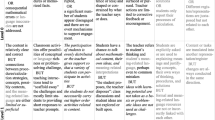Abstract
The purpose of this article is twofold: (a) to describe a unique teacher licensure program for grades 7–12 that integrates mathematics, science, and technology education and (b) to explore the attitudes and perceptions related to the integration of mathematics, science, and technology education of three cohorts of preservice teachers enrolled in the first 3 years of the program. Eighty-one preservice teachers responded to a semantic differential to measure attitudes and perceptions related to “mathematics, science, and technology education integration.” Principal components and internal consistency reliability analyses were computed to provide validity and reliability evidence. Preservice teachers also responded to one open-ended, free-response written question, “What does the integration of mathematics, science, and technology education mean to you?” Multivariate and univariate analyses of variance with repeated measures and Pearson cross-tabulation chi-square analyses were computed to identify pretest–posttest differences for the value and difficulty scales, identified by the principal components analysis. Analytic inductive methods were used to identify emergent themes in student written responses to the open-ended question. Results indicated no change in preservice teacher attitudes and perceptions related to the value of integration—they clearly valued integration at the onset and completion of the program, often citing student benefits. However, a significant change in preservice teacher attitudes and perceptions related to difficulty was noted. Upon completion of the program, preservice teachers perceived integration to be more difficult and identified barriers and challenges—demonstrating a more realistic, practical, and cautious approach to the integration of mathematics, science, and technology education.
Similar content being viewed by others
References
American Association for the Advancement of Science. (1993). Benchmarks for science literacy. New York: Oxford University Press.
Austin, J. D., Converse, R. E., Sass, R. L., & Tomlins, R. (1992). Coordinating secondary school science and mathematics. School Science and Mathematics, 92, 64–68.
Bell, C., & Denniston, K. J. (Eds.). (2002). Journeys of transformation II: The impact of the Maryland Collaboration for Teacher Preparation on science and mathematics instruction. Successful strategies and results of a reform-based effort to improve science and mathematics instruction and teacher preparation. Towson University, Center for Science and Mathematics Education, Towson, MD. ERIC Reproduction Document Service No. ED467606.
Foss, D. H., & Pinchback, C. L. (1998). An interdisciplinary approach to science, mathematics, and reading: Learning as children learn. School Science and Mathematics, 98, 149–155.
Frykholm, J., & Glasson, G. (2005). Connecting science and mathematics instruction: Pedagogical context knowledge for teachers. School Science and Mathematics, 105(3), 127–141.
Haigh, W., & Rehfeld, D. (1995). Integration of secondary mathematics and science methods course: A model. School Science and Mathematics, 95, 240–247.
International Technology Education Association. (2000). Standards for technological literacy: Content for the study of technology. Reston, VA: International Technology Education Association.
Johnson, J. R. (1989). Technology. Report of the Project 2061 Phase I Technology Panel. Washington, DC: American Association for the Advancement of Science.
Koirala, H. P., & Bowman, J. K. (2003). Preparing middle level preservice teachers to integrate mathematics and science: Problems and possibilities. School Science and Mathematics, 103(3), 145–154.
Lehman, J. R. (1994). Integrating science and mathematics: Perceptions of pre-service and practicing elementary teachers. School Science and Mathematics, 94, 58–64.
Lehman, J. R., & McDonald, J. L. (1988). Teacher perceptions of the integration of mathematics and science. School Science and Mathematics, 88, 642–649.
Lonning, R. A., & DeFranco, T. C. (1994). Development and implementation of an integrated mathematics/science preservice elementary methods course. School Science and Mathematics, 97, 18–25.
McGinnis, J. R., Parker, C., & Roth-McDuffie, A. (1999). An investigation in preparing teacher candidates to make connections between science and mathematics. Paper presented at the annual meeting of the National Association for Research in Science Teaching, Boston, MA. ERIC Reproduction Document Service No. ED429830.
Meier, S. L., Cobbs, G., & Nicol, M. (1998). Potential benefits and barriers to integration. School Science and Mathematics, 98, 438–445.
Miller, K., Metheny, D., & Davison, D. (1997). Issues in integrating mathematics and science. Science Educator, 6(1), 16–21.
National Council of Teachers of Mathematics. (1989). Curriculum and evaluation standards for school mathematics. Reston, VA: National Council of Teachers of Mathematics.
National Council of Teachers of Mathematics. (1991). Professional standards for teaching mathematics. Reston, VA: National Council of Teachers of Mathematics.
National Council of Teachers of Mathematics. (1995). Assessment standards for school mathematics. Reston, VA: National Council of Teachers of Mathematics.
National Council of Teachers of Mathematics. (2000). Principles and standards for school mathematics. Reston, VA: National Council of Teachers of Mathematics.
National Research Council. (1996). National science education standards. Washington, DC: National Academies.
Osgood, C. E., Succi, G. J., & Tannenbaum, P. H. (1957). The measurement of meaning. Urbana: University of Illinois Press.
Pang, J. S., & Good, R. (2000). A review of the integration of science and mathematics: Implications for further research. School Science and Mathematics, 100, 73–82.
Steen, L. A. (1994). Integrating school science and mathematics: Fad or folly? In D. F. Berlin (Ed.), NSF/SSMA Wingspread Conference: A network for integrated science and mathematics teaching and learning. Conference plenary papers (pp. 7–12). Columbus, OH: The National Center for Science Teaching and Learning.
Stuessy, C. L. (1993). Concept to application: Development of an integrated mathematics/science methods course for preservice elementary teachers. School Science and Mathematics, 93, 55–62.
Watanabe, T., & Huntley, M. A. (1998). Connecting mathematics and science in undergraduate teacher education programs: Faculty voices from the Maryland Collaborative for Teacher Preparation. School Science and Mathematics, 98, 19–25.
Wicklein, R. C., & Schell, J. W. (1995). Case studies of multidisciplinary approaches for integrating mathematics, science and technology education. Journal of Technology Education, 6(2), 59–76.
Author information
Authors and Affiliations
Corresponding author
Rights and permissions
About this article
Cite this article
Berlin, D.F., White, A.L. PRESERVICE MATHEMATICS AND SCIENCE TEACHERS IN AN INTEGRATED TEACHER PREPARATION PROGRAM FOR GRADES 7–12: A 3-YEAR STUDY OF ATTITUDES AND PERCEPTIONS RELATED TO INTEGRATION. Int J of Sci and Math Educ 8, 97–115 (2010). https://doi.org/10.1007/s10763-009-9164-0
Received:
Accepted:
Published:
Issue Date:
DOI: https://doi.org/10.1007/s10763-009-9164-0



